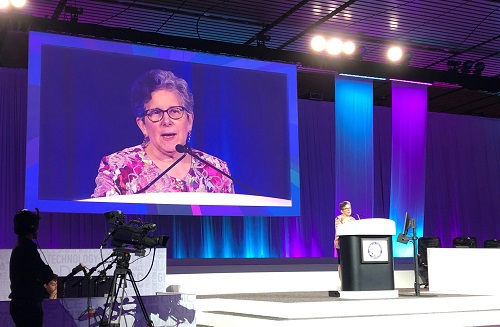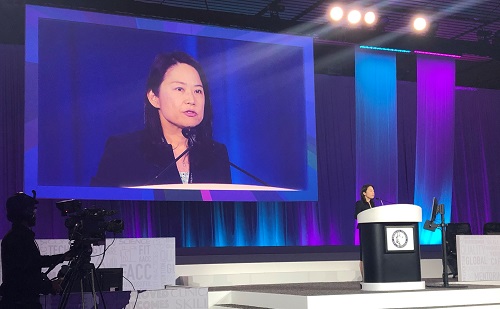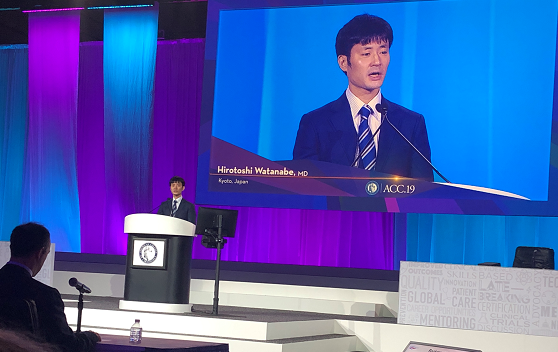Live From New Orleans: Days 2 and 3 at ACC 2019
Day 2 was jam-packed with more TAVR plus COAPT, AUGUSTUS, and beyond. Today promises antihypertensives, lipid-lowering, DAPT, omega-3s and more.

NEW ORLEANS, LA—Anyone who went looking for the Live Blog on Saint Patrick’s Day was out of luck: I was too busy writing and editing the news for TCTMD to bring you a quick synopsis. Find our coverage of AUGUSTUS, the low-risk TAVR trials, WRAP IT, bicuspid TAVR, the primary prevention guidelines, the COAPT echocardiographic and quality-of-life substudies, POET, and much, much more on the TCTMD homepage.
That includes a deep dive into the tricky business of quantifying cath lab quality in the wake of the latest NCDR Cath Lab PCI Registry “upgrade” by our Off-Script blogger, Kwan Lee.
Today, CLEAR Wisdom was the first trial of the morning, showing that bempedoic acid safely lowered LDL cholesterol in high-cardiovascular-risk patients with high LDL cholesterol already treated with maximally tolerated statins and other lipid-modifying therapies.
 CREOLE compared three combinations of antihypertensives in black Africans in sub-Saharan Africa, seeking to identify the best combination in this undertreated and understudied population. The trial concluded that patients who received amlodipine plus HCTZ or amlodipine plus perindopril had bigger reductions in ambulatory systolic BP than did patients who received perindopril plus HCTZ.
CREOLE compared three combinations of antihypertensives in black Africans in sub-Saharan Africa, seeking to identify the best combination in this undertreated and understudied population. The trial concluded that patients who received amlodipine plus HCTZ or amlodipine plus perindopril had bigger reductions in ambulatory systolic BP than did patients who received perindopril plus HCTZ.
Sticking with blood pressure, INFINITY broached the sticky subject of aggressive versus standard BP-lowering in elderly men and women with hypertension and cerebrovascular disease, looking specifically at the effect on cerebrovascular damage. Here, investigators showed that white matter hyperintensity accrual on MRI was significantly lower in the intensive BP-lowering group (who kept their 24-hour systolic blood pressure levels in the 130 mm/Hg range) as compared with patients with 24-hour systolic BP around 145 mm/Hg over 3-year follow-up. That difference, however, was not reflected in measures of declining mobility, something investigators feel may relate to the relatively short duration of follow-up.
INFINITY trial - intensive BP lowering (130 systolic) in over 75s reduces white matter hyperintensity lesions on brain MRI and major CV events but no change in cognitive function at 3 years #ACC19 pic.twitter.com/jK6mMHESKw
— Zaid Iskandar (@zaidiskandar85) March 18, 2019
Next up, new data from the 17,000-patient DECLARE-TIMI 58 trial of dapagliflozin on heart failure and mortality in type 2 diabetes delved into drug treatment effects based on baseline ejection fraction, captured in 5,202 patients. Here, investigators found that the much-celebrated cardiovascular benefits of this SGLT2 inhibitor appear more pronounced in patients with reduced ejection fraction, who experienced a 38% drop in hospitalizations for heart failure or CV death as compared with placebo. By contrast, that drop was just 12% in patients with patients who did not have heart failure with reduced ejection fraction.
 In the final late breaker of this morning’s session, got new data from REDUCE-IT. This was the prescription strength omega-3 trial using icosapent ethyl first presented at the 2018 American Heart Association meeting that addressed patients with high triglycerides at high CV risk, with an endpoint of CV death, MI, stroke, coronary revascularization, or unstable angina. Now, investigators have drilled into the trial data to focus on looking not only at first CV events, but any additional events that occurred over the 5-year course of the trial. Here, icosapent ethyl reduced total CV events by 30% compared with placebo.
In the final late breaker of this morning’s session, got new data from REDUCE-IT. This was the prescription strength omega-3 trial using icosapent ethyl first presented at the 2018 American Heart Association meeting that addressed patients with high triglycerides at high CV risk, with an endpoint of CV death, MI, stroke, coronary revascularization, or unstable angina. Now, investigators have drilled into the trial data to focus on looking not only at first CV events, but any additional events that occurred over the 5-year course of the trial. Here, icosapent ethyl reduced total CV events by 30% compared with placebo.
#ACC19 REDUCE IT post-hoc dataset analysis RRR 30% for total CVE @VietHeartPA @pabeda1 @drpablocorral @ErinMichos @AngoulvantD pic.twitter.com/JJ7NIPaTrZ
— SABOURETCardiologist (@SABOURETCardio) March 18, 2019
Full results for all of these trials will be up on TCTMD soon.
*****
The fifth and final late-breaking clinical trial session of #ACC19 is already receding in the rear-view window. The TCTMD team is hammering out their coverage of the following trials; stories should be live later today.
SAFARI-STEMI is looking at the safety and efficacy of femoral versus radial access in primary PCI/STEMI, a patient subset in whom the supremacy of radial continues to be debated. In this 2,200-patient trial, investigators found no difference in survival at 30 days between the two access sites.
#RadialFirst Vs #SafeFemoral #SAFARI-STEMI #ACC19 #ACCIC no difference in mortality, bleeding!!!! Lower radiation in femoral @mirvatalasnag @SVRaoMD @KaulP pic.twitter.com/EV1ITA6vwR
— Shariq Shamim, MD, FACC (@ShariqShamimMD) March 18, 2019
 In results that will prompt some rejoicing among interventionalists on-call, COACT found that a strategy of immediate angiography does not appear to improve survival compared with a delayed strategy in the majority of cardiac arrest patients who are successfully resuscitated and who have no signs of STEMI.
In results that will prompt some rejoicing among interventionalists on-call, COACT found that a strategy of immediate angiography does not appear to improve survival compared with a delayed strategy in the majority of cardiac arrest patients who are successfully resuscitated and who have no signs of STEMI.
The TREAT trial is back. Thirty-day results were released at last year’s ACC meeting; now, 12-month results show no difference in rates of cardiovascular events at 12 months among patients aged under 75 years with STEMI, given ticagrelor after fibrinolytic therapy.

Rounding out the session, two dual antiplatelet therapy (DAPT) studies offer some support for shortening the duration of this strategy following current-generation DES implantation--but in a new twist, dropping aspirin, not the P2Y12 inhibitor. STOPDAPT2 suggests that 1 month of DAPT followed by clopidogrel monotherapy provides a net clinical benefit for ischemic and bleeding events compared with 12 months of DAPT among Japanese patients implanted with an everolimus-eluting stent. Taking a different approach, SMARTCHOICE found that switching to P2Y12 inhibitor monotherapy after 3 months of DAPT was noninferior to 12-month DAPT for the primary endpoint of MACCE at 1 year.
Click here to see the latest slides presentations from ACC 2019.
Shelley Wood was the Editor-in-Chief of TCTMD and the Editorial Director at the Cardiovascular Research Foundation (CRF) from October 2015…
Read Full Bio

Comments